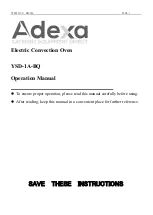
electrolux
17
17
Conventional Cooking
- The middle shelf position allows for the best
heat distribution. To increase base browning
simply lower the shelf position. To increase top
browning, raise the shelf position.
- The material and finish of the baking trays and
dishes used will affect base browning.
Enamelware, dark, heavy or non-stick utensils
increase base browning, while oven
glassware, shiny aluminium or polished steel
trays reflect the heat away and give less base
browning.
- Always place dishes centrally on the shelf to
ensure even browning.
- Stand dishes on suitably sized baking trays to
prevent spillage onto the base of the oven and
make cleaning easier.
-
Do not
place dishes, tins or baking trays
directly on the oven base as it becomes very
hot and damage will occur.When using this
setting, heat comes from both the top and
bottom elements. This allows you to cook on
a single level and is particularly suitable for
dishes which require extra base browning
such as quiches and flans.
Gratins, lasagnes and hotpots which require
extra top browning also cook well in the
conventional oven.
How to use the conventional oven
1. Turn the oven function control knob to the
required cooking function
.
2. Turn the thermostat control knob to the
required temperature.
Pizza
1. Turn the oven function control knob to the
required cooking function
.
2. Turn the thermostat control knob to the required
temperature.
The bottom element provides direct heat to the base
of pizzas, quiches or pies, while the fan ensures air
is circulated to cook the pizza toppings or pie
fillings.The grill element provides heat from the top to
obtain top browning.
Hints and Tips
On baking:
Cakes and pastries usually require a medium
temperature (150°C-200°C) and therefore it is
necessary to preheat the oven for about 10
minutes.
Do not open the oven door before 3/4 of the
baking time has elapsed.
Shortcrust pastry is baked in a springform tin or
on a tray for up to 2/3 of the baking time and then
garnished before being fully baked. This further
baking time depends on the type and amount of
topping or filling. Sponge mixtures must separate
with difficulty from the spoon. The baking time
would be unnecessarily extended by too much
liquid.
If two baking trays with pastries or biscuits are
inserted into the oven at the same time, a shelf level
must be left free between the trays.
If two baking trays with pastries or biscuits are
inserted into the oven at the same time, the trays
must be swapped and turned around after about
2/3 of the baking time.
On Roasting:
Do not roast joints smaller than 1 kg. Smaller
pieces could dry out when roasting. Dark meat,
which is to be well done on the outside but remain
medium or rare inside, must be roasted at a
higher temperature (200°C-250°C).
White meat, poultry and fish, on the other
hand, require a lower temperature (150°C-
175°C). The ingredients for a sauce or gravy
should only be added to the roasting pan right at
the beginning if the cooking time is short.
Otherwise add them in the last half hour.
You can use a spoon to test whether the meat
is cooked: if it cannot be depressed, it is cooked
through. Roast beef and fillet, which is to remain
pink inside, must be roasted at a higher
temperature in a shorter time.
If cooking meat directly on the oven shelf,
insert the roasting pan in the shelf level below to
catch the juices.
Leave the joint to stand for at least 15 minutes,
so that the meat juices do not run out.
Downloaded from www.vandenborre.be
















































